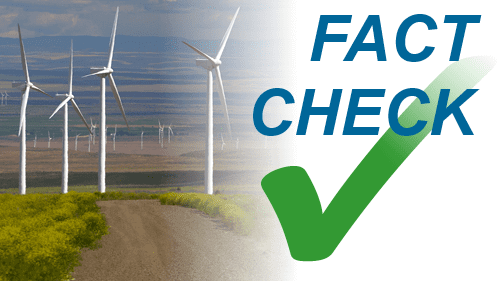Fact check: Wind power is a story of American growth and innovation
Many people know that wind energy creates benefits in all 50 states, providing affordable, reliable electricity for millions of American homes and businesses. It also supports over 105,000 well-paying U.S. jobs while reducing harmful pollution. Yet a recent article by Stephen Moore ignores all of this, instead spreading misleading claims and outdated information.
The fact of the matter is that wind power, along with other renewables, helps meet America’s demand for affordable energy. Over the past decade, the cost of renewables has fallen as we continue to innovate and improve transmission. In the last eight years alone, the cost of wind power has dropped over 67 percent, making it the cheapest source of new electricity in many parts of the country.
States red and blue have enthusiastically embraced wind. For example, in 2017, Iowa generated over 36 percent of its electricity using wind. It’s also noteworthy that Iowa has among the lowest electricity rates in the country, pouring cold water on the notion that wind energy is expensive.
Colorado is another state where wind’s cost savings are on display. In response to an RFP from Xcel Energy for new generating capacity earlier this year, wind power led the way by a significant margin, clocking the lowest median bid of $18.10/megawatt hour (MWh)—it was substantially cheaper than every other type of new electricity.
These innovations and cost reductions have also helped ensure wind’s reliability. Wind has shown it can improve resilience during severe weather. Wind is distributed, making it less likely that a single event will affect your lights being on. Take the “polar vortex” of 2014. While freezing temperatures contributed to unexpected equipment failures and fuel shortages at conventional power plants, wind turbines continued operating. That saved consumers in the Mid-Atlantic and Great Lakes regions $1 billion on their electric bills in only two days.
But cost reductions, reliability, and new jobs are not the only ways wind has contributed to the country. Wind has also helped reduce harmful air pollution that creates smog and triggers asthma attacks. Air pollution also happens to be more prevalent in low-income areas, meaning wind can help improve health outcomes there. In fact, wind energy created $8 billion in public health savings in 2017 alone by contributing to cleaner air.
These are tangible savings and quality of life benefits for everyone, especially low-income and rural communities. And wind power brings huge amounts of economic development to communities most in need of new opportunities—over 75 percent of wind projects are built in low-income areas. That means job creation and new revenue go right to the people who need it most.
It is disingenuous to ignore the many benefits wind energy delivers. Especially when many of those benefits go to communities in need of new revenue. Indeed, the market is choosing wind and for good reason.




